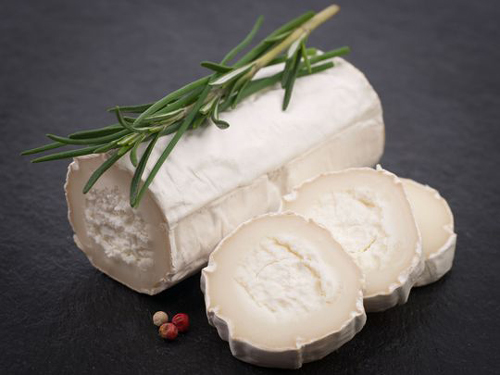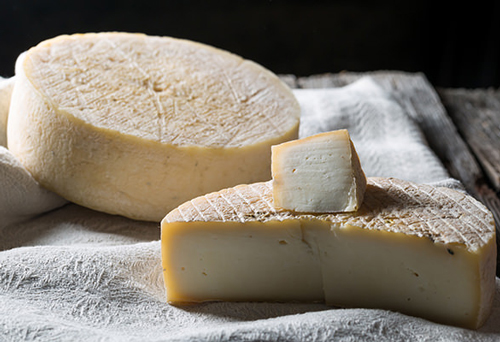Six goat cheese benefits, nutrition facts and recipes (1)

If you’re a lover of cheese, you might wonder what kind of cheese, if any, is good for you. Goat cheese, with its tangy taste and crumbly texture, has earned a reputation as being one of the healthiest cheese choices there is. What are some of the reasons that nutritionists and even certain obesity experts now recommend eating goat cheese (that is if you can tolerate it)? Goat cheese provides healthy fats, is easier for many people to digest than cow’s milk cheeses, and is even a bit lower in calories and fat than other cheeses.
Cow milk and goat milk are by far the two most popular types used to make dairy products like yogurt, kefir and cheese. While good-quality cow milk does have certain benefits – consuming raw milk from A2 casein cows whenever possible is recommended – there are a number of reasons why you might want to have goat milk instead. Some people simply prefer the unique taste of goat’s milk to other cheeses, but as you’ll learn, goat’s milk also has a chemical composition that makes it a superior choice for many people.
People living in places such as France have been consuming high-quality goat cheeses for thousands of years – in fact, historians believe that goat’s cheese was likely one of the first dairy products to ever be consumed. With some effort you can still find traditionally made, organic and even raw goat cheeses today that provide you with protein, calcium and other essential nutrients. Let’s take a look at what makes goat cheese a good addition to your diet, how it’s different from other cheeses (such as cottage cheese and feta cheese) and what types of goat cheese recipes you might consider making.
Six Goat Cheese Benefits
According to the Journal of Dairy Science, “Numerous varieties of goat milk cheeses are produced worldwide. Proteolysis and lipolysis are two major biochemical processes in the multifaceted phenomenon of cheese aging, which involves a variety of chemical, physical, and microbiological changes under controlled environmental conditions.”
Like other cheeses, goat cheese is made by allowing raw milk to curdle, coagulate and thicken. The milk is then drained, leaving behind curds of tasty, high-fat cheese. A traditional way of making soft or semi-soft goat cheese is to fill cheesecloths with curds and then to hang them in warm kitchen for several days to cure. Certain types of goat cheeses are then aged by storing them in cool places for several months so they can continue to cure and harden.
Factors that influence how goat cheese turns out include: fatty acid composition, lipolytic enzymes, starter and nonstarter bacteria that are present, pH and moisture levels of the curds, storage temperature and time, salt content, salt-to-moisture ratio, surface area that is exposed, and humidity.
Below are some of the major benefits associated with goat cheese:
1. Provides Healthy Fats
Why is goat cheese a source of healthy fat? A serving of full-fat goat cheese provides about six grams of fat, much of which is saturated fat. Even though saturated fat has earned a reputation for being unhealthy and “dangerous” for your heart, there’s a lot of evidence that this isn’t the case. For example, France is one of the world’s leading consumers of cheese and butter, yet the French don’t have higher rates of heart disease compared to other nations that consume less. In fact, “the French paradox” describes the low rates of coronary heart disease death rates in France despite high intake of dietary cholesterol and saturated fat. Healthy fats are an important part of every diet because fat helps facilitate nutrient absorption, hormone production, protects neurological health and much more.
Overall cow and goat milk have similar amounts of fat, but the fat globules found in goat milk are smaller and tend to be easier to digest. Compared to cow’s milk, goat’s milk has a higher proportion of medium-chain fatty acids (MCFAs), including caproic acid, caprylic acid and capric acid. This is one reason why goat’s milk products have a more tart flavor to compared to cow’s milk. MCFAs are also found in fatty foods like coconut oil and coconut milk; they have been shown to help support energy metabolism and are easily digested, even by people who have a hard time metabolizing fats.
Caprylic acid found in goat milk and goat cheese has been found to possess antibacterial, antiviral, antifungal and anti-inflammatory properties. Consuming caprylic acid may be helpful for fighting fungal and yeast infections, such as candida, urinary tract infections, acne, digestive problems and more.
Can you eat goat cheese if you’re following a low-carb diet, such as the ketogenic diet? Yes, and you probably should. Goat’s milk kefir, a fermented “drinkable yogurt”, contains some sugar (about nine to 12 grams per cup), which means it’s probably not the best choice for a very low-carb diet. But full-fat goat’s cheese contains much less sugar and carbs, only about a gram. During the fermentation process when cheese is made, the bacteria in the milk “eat” the sugar, resulting in much fewer carbs and sugar left over. To keep carbs to a minimum, avoid eating any processed cheeses, flavored cheeses (such as those blended with honey or fruit) and always get grass-fed, full-fat cheese.
2. Good Source of Protein and Calcium

Like other dairy products, goat’s milk and goat cheese are great sources of calcium, which can be hard to get enough of if someone doesn’t eat many green veggies, nuts or much seafood. Having a serving or two of high-quality dairy products per day, which can include goat cheese and other raw cheeses, can provide about 10 percent to 30 percent of your daily calcium needs depending on the specific kind.
Calcium is an essential mineral for helping build bones, maintaining a strong skeletal system, supporting dental health and more. Emerging research even shows that consuming more calcium from your diet in combination with vitamin D (from both sunlight and food sources) may have the ability to regulate glucose metabolism and help protect against cancer, diabetes and heart disease. Calcium also helps balance levels of other minerals, including magnesium, phosphorus and potassium. These minerals work together to maintain balance of bodily fluids and regulate heart rhythms, nerve and muscle function, blood pressure, and cholesterol levels.
A serving of goat cheese (one ounce) also provides about five to six grams of protein, making it a good addition to salads, roasted veggies and other low-protein sides. Studies have found that goat cheeses tend to be a bit lower in protein than cow’s milk cheeses because they experience greater rates of protein degradation during the cheese-making process.
3. Supplies Probiotics (Beneficial Bacteria)
Probiotics can both grow naturally in fermented foods or be added by manufacturers to increase their concentration. It’s now common for cheese makers to add probiotic bacteria strains to cheese, just like they do with yogurt, because cheese turns out to be a good carrier for these microbes. Due to the fermentation process that cheeses undergo while they’re curing, aged/raw goat cheese (and other raw cheeses made from raw cow’s or sheep’s milk) are often high in probiotics, including thermophillus, bifidus, bulgaricus and acidophilus. The benefits associated with eating probiotic foods include improving gut health, enhancing immunity, and helping reduce allergies and inflammatory reactions.
The concentration of probiotics within different types of cheeses depends on factors like the amount of starter that’s used, the concentration of salt, the addition of a protein hydrolysate and the ripening time. Certain studies have found that these variables all affect the “microbiological, biochemical, and sensory properties of the cheese.” The amount of probiotics available from goat cheese can be optimized by the addition B. lactis and L. acidophilus, salt, and ripening for 70 days or more.
Aged, raw cheeses are more likely to be have higher probiotic concentrations because they are not exposed to high heat that kills beneficial (and harmful) bacteria. Goat cheese that contains probiotics may taste more acidic and tart (similar to goat’s milk yogurt or kefir) due to containing L. acidophilus or B. lactis.
4. Provides B Vitamins, Copper and Phosphorus
Along with protein and fat, goat’s cheese also provides phosphorus, copper, B vitamins like vitamin B6 and some iron. The combination of protein, calcium and iron may help support bone formation and help with absorption of certain minerals.
You can get about 10 percent to 20 percent of your daily copper (depending on the specific type of cheese) from having just one ounce of goat cheese. Getting enough copper is important for maintaining high energy levels because copper acts as a catalyst in the reduction of molecular oxygen to water, which is the chemical reaction that takes place when ATP is synthesized (the fuel that provides bodily energy). Copper is the third most prevalent mineral in the body and plays a role in skeletal health, hormone production, and the production of hemoglobin and red blood cell.
Phosphorus is the second most abundant element in the human body. Phosphorus benefits include supporting your metabolism, synthesizing the major macronutrients from your diet (proteins, fats and carbohydrates) and controlling muscle contractions.
5. May Be Easier to Digest

For people with sensitivities to dairy, why is goat cheese better than regular cheese? Goat milk can be a good choice for some people who can’t digest cow’s milk because its chemical structure is slightly different. Some experts even believe that goat cheese can be safely consumed by people who are allergic to cow’s milk. One reason is because goat’s milk is lower in lactose (milk sugars) than cow milk, and the presence of lactose is a major reason why some people cannot digest dairy very well.
To understand another reason why goat cheese is easier on digestion than cow’s milk cheese we need to go back thousands of years. Milk from cows, sheep and goats contain specific types of protein, one of which is called casein. In many cases, when people are intolerant of cow milk they are actually sensitive to A1 casein, a type of protein found milk produced by the majority of dairy cows in the U.S., Western Europe and Australia. Intolerance to A1 casein can contribute to problems such as gastrointestinal distress, irritable bowel syndrome, Crohn’s, leaky gut, acne and eczema.
Goat milk contains A2 casein, which is less inflammatory and less likely to cause an intolerance. In fact, the chemical composition of goat’s milk makes it very close to human breast milk, which is why some mothers have traditionally weaned their babies by giving them goat’s milk. Recently, the European Food Safety Authority stated that “proteins from goat’s milk can be suitable as a protein source for infant and follow-on formula.”
6. May Help Reduce Hunger and Cravings
Cheese probably doesn’t come to mind when someone mentions dieting and weight loss, but what do the studies say? Is goat cheese good for weight loss? Because goat cheese provides fat and protein, it can be helpful for controlling hunger because it’s satiating.
Another less obvious reason that goat cheese and other full-fat dairy products may be “good for you” is because they taste great and ultimately can makes recipes more enjoyable, which means you might need to eat less to feel satisfied. When you enjoy what you eat you’re less likely to seek out snacks and/or feel deprived, which can lead to a reduced risk for overeating in the long run. Rather than attempting to cut calories by eating low-fat, processed cheeses, many weight loss experts now recommend eating the real thing – full-fat, high-quality cheeses – and simply watching your portion size.
Read the second part of the article
yogaesoteric
February 7, 2019
